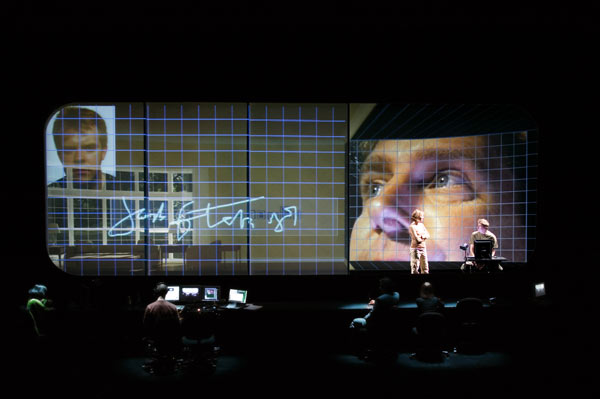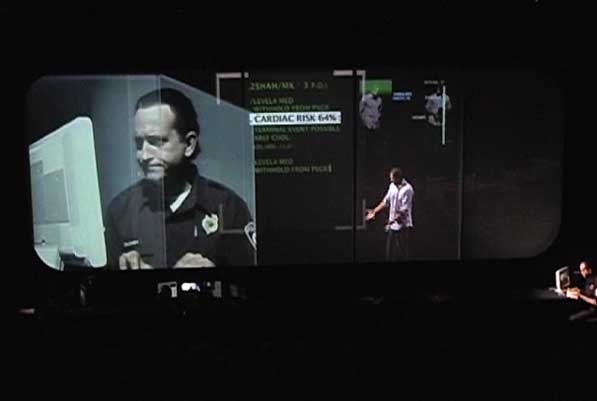3. A father covertly exploits his young son's personal data to meet the demands of the family's lifestyle. This ploy escalates beyond the father's control, until he is compelled to disappear. His wife and son are left with a starkly diminished data portrait, and his escape is shadowed by the long reach of the datasphere.
James Gibbs
Nick Kaye: There is also something uncanny about the family room, because it is so very realistic. It has the illusion of materiality, but also an immateriality that is announced in this movement and animation of objects. Peter Flaherty also suggested that this architecture has a kind of unblemished quality to it. He referred to Edward Hopper’s paintings in relation to this – to familiar spaces that seem slightly ominous.

Left to right: image of John Fletcher Jr. (Allen Hahn), Kyle deCamp (Carol), David Pence (John Fletcher Sr.) onstage and mediated live.
Photo by dbox.
James Gibbs: Although, I do think places increasingly looking like that. Everybody from dbox who worked on the teams for this project, I found out later, had some personal input. Christa Hamilton was the first person to set up that living room and she modelled it on her parent’s house. There was a huge amount of work by Ivor Ip, especially on the traveller, and the map that shows the house location– that is actually his family’s house in Toronto. He renamed the street so that it matched the script, but, physically, that is a map that identifies his house. So I think we are all having fun with that sort of thing.
Nick Kaye: When you are creating this are you thinking in terms of producing a certain level of materiality?
James Gibbs:We certainly had clear ideas about creating something with materiality in the family scene - and about breaking that or creating a tension with the base line of the father’s manipulation. Then also an idea about playing with materiality in different ways in the traveller’s story. But that story is a little less seeded in the real world - and part of that is related to what we did in JET LAG. One immigration hall is more or less any like any other - and it’s not the thing you are thinking about when you are occupying that space. Your up-coming transaction and your physical state - whatever physical state of distress you are in at the point of your travel - those are the only things that are present, it’s not ‘the room’.
Allen Hahn
Nick Kaye: It is very interesting because you are talking very specifically about the degree or tone of material presence and the relationship to the video that the performers have. This came across very strongly. So Rizwan Mirza (the traveller), toward the end, becomes quite strongly equivalent to his own projection - because they are the same size and you developed the lighting design to accent that specifically.

Left to right: Rizwan Mirza (the traveller), onstage; Joe Silovsky
(the TSA agent) mediated live and on forestage.
Video still.
Allen Hahn: Yes and as I say it was a conceptual point early on but it seemed to develop along a separate, more organic line based on what was happening in rehearsal, as the text was changing and the exchange between Rizwan Mirza and Joe Silovsky was evolving. It was very there – you know – the tone of their last conversation, in particular, which is very flat and… not dreamlike, but very flat and sort of by rote - and Rizwan Mirza become less character and more facts about his character.

Left to right: Joe Silovsky (the TSA agent), live mediated; Rizwan Mirza
(the traveller) onstage and, above, in projection; Joe Silovsky on forestage.
Video still.
Nick Kaye: And Joe Silovsky gets larger as this progresses.
Allen Hahn: And then, interestingly, in that last scene - it is no longer necessary for Joe Silovsky to be physically present at all either - to be seen by the audience - because his presence is felt so strongly. I mean, the only thing in the last scene we are watching is Rizwan Mirza and over the course of the two and half to three minutes of the scene he ends up going from fully lit to a silhouette against all the data projection and Joe Silovsky is never more than lit from above in the faintest light.
Nick Kaye: So Joe Silovsky, on the front desk, diminishes over…
Allen Hahn: No. Joe remains strong, but by that last scene the dynamic has so clearly – the power relationship is so clearly in Joe’s hands that his voice is enough. We don’t need to see him - and in fact it would lessen the dramatic impact if you were to see him - and that was strangely obvious too. Once we got to develop that part of the script. In rehearsal I turned the light on and then I turned it off and everyone agreed that was what it should be.
see also: the 'crush' scene | the family |
SUPER VISION credits




